|
|
|
Armchair Strategist's Martial Arts Pages |
 |
Various punches
Here is a collection of
punching methods. It is far from all-inclusive, indeed it is only
the tip of the iceberg.
Any fool
can fight, but few can box
In this section I've borrowed largely from Western boxing. Boxing
is widely recognised for it's highly developed punching
techniques and many more modern styles including Savate, Thai
Boxing, Jeet Kune Do and Kick boxing have borrowed from it. But
boxing is a sport involving gloves and with rules such as which
part of the fist 'scores'. This imposes limits on striking
methods and applications. For example you cannot grab an opponent
and pull them onto the punch -which may present itself in
self-defence. All the same, boxing derived punches are a good
starting point for learning to punch effectively.
In general terms a punch is given power by some or all of the following factors:
The Jab
In essence this is a
straight lead punch without too much power. By not applying all
of the power devises listed above, you can make it very fast and
'snappy'. This also has the benefit of not using up too much
energy which is particularly important in sparring.
The jab is mainly used for:
As such it is not a
knockout punch. You could argue that it is not very applicable on
the street because it doesn't do a lot of damage and likely
aggressors wouldn't block a less subtle move anyway. However, it
remains the most frequently thrown punch in boxing and very
usable in martial arts sparring.
In 'orthodox' boxing it is usually thrown with the left (weakest)
hand. However, you may wish to train this technique on both
sides.
| Example of a jab used as a counter In this scenario
the attacker (black T-shirt) throws a left jab. The
defender parries it with the palm of his guarding (right)
hand and deflects it outwards. Shuffling to his left and
slightly forward he simultaneously throws his own left
jab as a counter. |
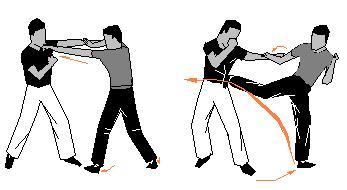 I've drawn the attacker's guarding hand lower than is likely so as not to obscure the counter. |
The Lead hook
This is often said to be the most effective punch in boxing. The main target is the chin or face. Start from a natural fighting stance with feet evenly weighted. Pivot sharply with your lead hip (your lead leg turning naturally). As you do this, lift your lead elbow and throw your fist in a tight arc to come back in across your centreline. As you impact, clench your fist tightly. Follow through, rotating your fist from bottom-down (before impact) to thumb-down. Retract immediately.
There are variations. The main issue is when (if at all) the fist is rotated. At the end of the day, effective hooks can be thrown with either the fist bottom-down or thumb-down. It's really only down to personal preference. Another issue is range. The arc of the fist can be varied to suit range. It can be long -almost a straight punch but with more elbow/shoulder action, or tight and hooking back. It is most powerful if the elbow is bent at a right-angle and this is often seen as the optimum range.
| The
diagram on the right shows that a lead hook thrown from a
'cocked' position (#2) travels further and has more
hip/elbow action than one thrown without chambering (#1).
#2 is therefore a more powerful punch. Because the hook travels further and the elbow is thrown before the fist makes contact, it is slower and less subtle than a straight punch. This reduces the likelihood of taking a skilled opponent by surprise if you lead with it, although this shouldn't be completely discounted. In self-defence, an (unskilled) aggressor is far less likely to block it anyway so this is less of an issue. |
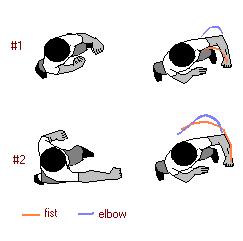 |
Example of a lead hook as a follow-up
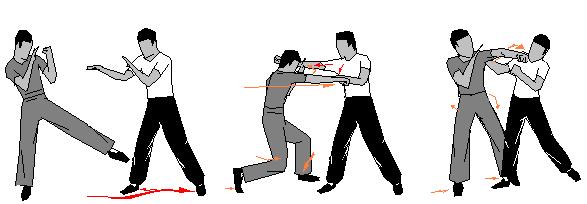
The above sequence places
the lead hook into a hypothetical sparring context. The attacker
(grey trousers) initiates with a low kick. The defender sees it
coming and changes stance so that it misses. The attacker
immediately follows up with a midsection straight right with his
left hand guarding his head. The defender sees the lunge coming
and shuffles to the attacker's outside, parrying with his left
and throwing a straight right -which is deflected outwards by the
attackers left. So far, neither has landed.
However, the attacker throws his trump. Sharply pivoting his hips
and shoulders forward to his left, he throws a tight lead hook
inside (and overtop) of the defender's still partially extended
lead hand. Wallop!
The straight right (or rear-hand)
This is often (usually incorrectly) described as the "cross". It also equates to a classical reverse punch although the structure and mechanics vary greatly from style to style. When I call it the 'straight right' I really mean straight rear-hand punch, it's just that orthodox boxing stands left side on. Again, consider practicing this on both sides.
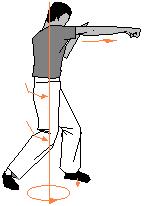 |
The
straight rear-hand punch is thrown by pivoting the waist
behind the punch, with the lead hip as a fulcrum. The
rear shoulder is thrown forwards. Although the mechanics
are initiated with a push off with the rear foot, the
rear leg is kept bent, the rear knee coming forward
behind the punch. The lead foot is momentarily rooted to
provide a stable platform and shock absorbing structure. The hand is twisted from bottom-fist down to thumb-down (i.e. anti-clockwise for a right rear-hand punch). Impact an inch or two before the arm is fully extended (punch through) and do not clench the fist too soon. Some habits to avoid:
|
| An interesting comparison can be made with the classical reverse punch (right). The boxer's structure is more loose and dynamic but in practice boxer's tend to punch more powerfully. The karate habit of 'corkscrewing' the fist and pulling back with the lead hand (to the waist) is, IMHO, of dubious merit. This does not mean that a reverse punch isn't effective if it lands of course. Other issues include the lack of a guard whilst punching and TMA's habit of not tucking the chin in. But exact stances and fist structures differ from style to style. | 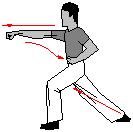 |
The rear uppercut
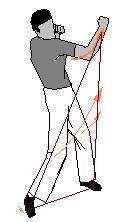 |
Again
I've chosen a boxing derived mechanism. The punch is
thrown with many of the same mechanics as the straight
rear-hand punch but with the hips lifted behind the
punch, which travels in an upward arc impacting with the
fist inverted. The punch is normally thrown at the chin
although variations can be thrown to the body (similar to
the body hooks of many boxers) or groin. See left. The main issue with this method is that lifting the hips also raises the centre of gravity. |
| Bowler uppercut counter In boxing a long uppercut is often called a 'bowler' as in bowling because of the motion. One counter using this technique is as follows: As the attacker throws a straight right (as part of a combination) the defender slips to the left (stepping forward and outward whilst dodging to evade the punch) and simultaneously delivers a long uppercut to the opponents chin. Note that the defender's lead hand covers the punch. A variation on this theme is that following an inward deflection with the lead palm, the defender counters with the long uppercut under the partially extended right of the opponent. |
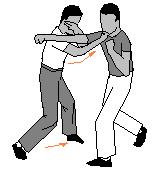 I've drawn the attacker's guarding hand lower than is likely so as not to obscure the counter. |
The rear hook
This is a much-neglected method in boxing, except perhaps in infighting. The reason for this is that it lacks range and travels the longest distance thus being the least subtle technique in the boxer's repertoire. However, it is also the most powerful method.
In simple terms it is much the same as the lead hook except that it is thrown with the rear hand. It is not to be confused with a stepping forward lead hook (very rare in boxing).
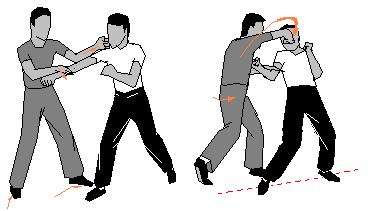 |
Example of a rear hook in application The defender deflects and traps the attacker's right lead. Stepping forward he uses a sliding punch ('short-fist') to control the extended lead and punch him in the face. Short-fist punches like this tend not to be very powerful. There the defender follows up by releasing the trap and throwing a right hook to the opponents face. The right hook comes in perpendicular to the opponent's balance plane (see dotted line). This is likely to push the opponent over, as well as hurt a lot. |